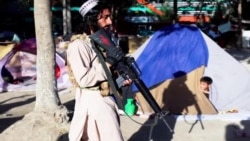On October 13, the Taliban’s minister for information and culture, Khairullah Khairkhwa, gave an interview to Qatar’s Al Jazeera state news channel. One issue covered: the treatment of journalists following the Taliban seizure of Afghanistan in mid-August.
Khairkhwa said the media should not promote division and focus on the positive as well as the negative in the country. He also claimed that women in media and other jobs do not face obstacles as long as they stick to Islamic traditions and wear hijab (head coverings).
Khairkhwa further claimed that the foreign forces that left Afghanistan took with them media outlets they had opened. Afghan media, he insisted, were still operating.
“We did not shut down any newspaper or TV channel,” Khairkhwa said.
That is misleading.
In fact, numerous reports say the Taliban have intimidated and threatened local media outlets to silence or control them, often targeting broadcasters that employed women. And they have introduced repressive limits to what journalists can and can’t report.
The Taliban have explained their media policy as meant to ensure that journalists present what Khairkhwa called a “true image of the country.” To that end, the Taliban on September 19 announced “11 rules of journalism.” Among other things, the rules forbid publishing content that is “contrary to Islam,” “insults national figures” or violates privacy interests.
The press freedom watchdog Reporters Without Borders said these rules are vaguely worded and likely to be used to muzzle and persecute journalists.
The group’s secretary-general, Christophe Deloire, said journalists in Afghanistan were not consulted as these rules were formulated. Deloire called them “spine chilling because of the coercive use that can be made of them.”
Radio Dehrawud in southern Afghanistan’s Uruzgan province went silent in July after the Taliban captured the Dehrawud district. The station’s director, Mohammad Omar Waziri, said the Taliban refused entry to the station’s offices, then looted and destroyed them.
Some media outlets were forced to change operations under Taliban restrictions. Banno TV channel found itself in a difficult spot because all its 550 employees are women. The station, which is owned by women, had to temporarily shut down, leaving everyone jobless.
Banno owner Zahra Nabi told the English-language Indian outlet WION that she was instructed that “women are not allowed to work.”
“We have shut down our analogue transmission in Kabul and other provinces, but now we are active over our social media and website,” Bashir Ahmad Rustaqi, CEO of Banno TV, told the Voice of America on October 14. “Due to Taliban not allowing women to work from an office, we had to close our office, too.”
Banno TV’s staffers are now working from home online and on social media.
On July 15, the private Samaa radio station shut down in Ganzi province, southeast Afghanistan. Samaa officials said Taliban leaders in the area sent written threats about the station’s employment of women and forced the station’s director to suspend broadcasts.
Taliban spokesman Zabihullah Mujahid denied responsibility for the threats, claiming many people falsely identify themselves as Taliban.
After Kabul fell on August 15, MILMA, the first local radio station in eastern Paktika province, was forced to close down, the Afghan Khaama News agency reported.
MILMA’s owner and manager, Yaqoob Manzoor, blamed “financial problems and an inappropriate working environment,” leaving 35 employees jobless.
Since May, when the Taliban launched its offensive in the provinces as the United States planned its pull-out, at least 51 media outlets have shut down, leaving more than 1,000 journalists jobless, including 150 women, according to NAI, an Afghan media advocacy group.
The Afghan Journalists Center (AFJC) said in a September report that dozens of radio and TV stations had either closed or been taken over by the Taliban, and that many journalists and media professionals fled the country fearing reprisals.
In the southern Helmand province alone, only five of the 16 radio and TV stations broadcasting before the Taliban’s takeover survived, according to a local journalist who spoke to Voice of America on condition of anonymity for safety reasons.
In August, the Afghan Journalists Safety Committee (AJSC), denounced Taliban intimidation and violence aimed at journalists. The group said reporters had been shot at and arrested, and that the owner of the Sada-e Paktia Media Center in Kabul had been assassinated. (As of August 11, no group claimed responsibility for the assassination, the AJSC reported.)
“It is noteworthy that such violence is in direct contrast to the official statements made by the Taliban leaders,” the center reported. “The Taliban must understand that freedom of expression finds meaning in the presence of criticism, disagreement, and the publication of facts.”
Since May, Afghanistan has experienced an exodus of journalists. Foreign Policy reported that they fled for their lives, fearing retaliation “unless they start pumping out favorable copy.”
Reporters Without Borders ranked Afghanistan 122nd out of 180 countries in its 2021 World Press Freedom Index, which was released in April, before the Taliban seized power.
Correction: An earlier version of this fact check cited the wrong date for spokesman Khairullah Khairkhwa's statement about media closures. His title also has been corrected.







